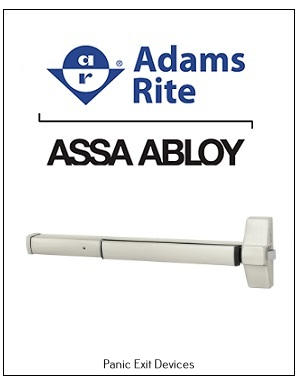When it comes to the safety of a building’s occupants, few things are as crucial as reliable panic exit devices. These unassuming pieces of hardware can be the difference between a safe and orderly evacuation during an emergency and chaos that puts lives at risk. In this article, we’ll explore the world of panic exit devices, their importance, types, and the regulations governing their use. At National Lock Supply, we understand the critical role panic exit devices play in ensuring the safety of building occupants during emergencies. Our top-quality panic exit devices are designed for quick and efficient egress, preventing panic and enabling a smooth evacuation.
The Vital Role of Panic Exit Devices
Panic exit devices, also known as panic bars, crash bars, or push bars, are mechanisms designed to facilitate quick and efficient egress from a building during emergencies. They are typically installed on exit doors in commercial, public, and industrial buildings. In the event of a fire, earthquake, or any other emergency requiring a rapid exit, these devices allow occupants to leave the building quickly without struggling with conventional doorknobs or handles.
The primary objective of panic exit devices is to prevent panic and stampedes during an evacuation. They provide a simple and intuitive means of exiting, allowing even people in a state of distress to escape easily.
Types of Panic Exit Devices
Panic exit devices come in various forms, each suited to different architectural and security requirements:
1. Rim Exit Devices: These are the most common type and are installed on the surface of the door. They consist of a horizontal bar that, when pushed, retracts the latch and allows the door to open. Rim exit devices are highly visible and easy to operate.
2. Mortise Exit Devices: Mortise exit devices are installed inside the door, making them less conspicuous from the outside. They are often preferred for aesthetic reasons, but they provide the same level of security and functionality as rim devices.
3. Vertical Rod Exit Devices: These devices have vertical rods that extend from the panic bar to both the top and bottom of the door. They are typically used on double doors and offer enhanced security and stability.
4. Concealed Exit Devices: As the name suggests, concealed exit devices are hidden within the door itself. They are a discreet option for buildings where aesthetics are a top priority.
5. Electric Exit Devices: Some panic exit devices can be integrated with access control systems, allowing for remote locking and unlocking. These are common in commercial buildings where security is paramount.
Regulations and Compliance
The use of panic exit devices is subject to strict regulations to ensure safety and accessibility. In the United States, these devices are governed by the American National Standards Institute (ANSI) and the National Fire Protection Association (NFPA). Compliance with these standards is crucial to avoid potential legal issues and, more importantly, to protect the lives of building occupants.
The ANSI/BHMA (Builders Hardware Manufacturers Association) A156.3 standard outlines the requirements for Panic Exit Devices, including durability, operational testing, and installation guidelines. Meanwhile, the NFPA 101 Life Safety Code provides further guidelines for panic exit devices, especially in the context of fire safety.
It’s essential to consult with a professional locksmith or hardware specialist when selecting and installing panic exit devices to ensure they comply with these standards. Regular maintenance and testing are also essential to keep these devices in good working order.

Conclusion
Panic exit devices are an integral part of building safety, allowing for a quick and orderly evacuation during emergencies. They come in various types to suit different architectural needs and provide a crucial layer of security. Understanding the regulations and standards governing these devices is essential for both building owners and managers to ensure compliance and, more importantly, the safety of their occupants. Whether you’re designing a new building or upgrading an existing one, investing in reliable panic exit devices is a vital step toward creating a safe and secure environment for all. With a range of options to choose from, including rim, mortise, vertical rod, and concealed exit devices, we offer solutions to suit diverse architectural needs. Our products comply with ANSI and NFPA standards, providing peace of mind and security. Trust National Lock Supply for reliable panic exit devices because your safety is our top priority.”
For more information, contact us:
National Lock Supply
1-718-814-6300



